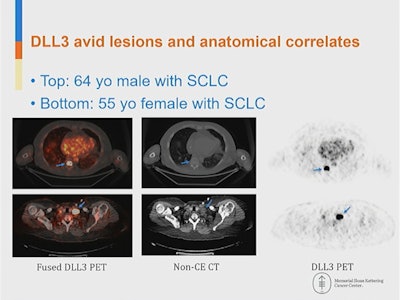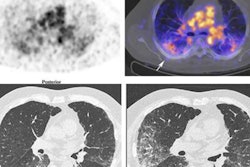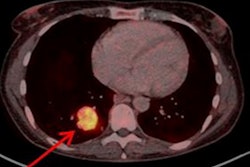
An experimental PET radiotracer is safe and appears effective for detecting neuroendocrine tumors (NETS) in patients with newly diagnosed or recurrent small cell lung cancer (SCLC), according to research presented Thursday at RSNA 2021 in Chicago.
A group at Memorial Sloan Kettering Cancer Center in New York City are conducting a phase I/II trial of a humanized monoclonal antibody (SC16.56) labeled with zirconium-89 (Zr-89) for PET imaging in patients with NETs. Findings from phase I in 10 patients indicate the radiotracer is safe and well-suited for the task.
"Zr-89 SC16.56 PET is a fit-for-purpose, first-of-kind [delta-like ligand 3] imaging marker in NET with multiple clinical applications, including tumor detection and response prediction," said Dr. Matthew Agee.
Small cell lung cancer is a very aggressive type of neuroendocrine tumor comprising approximately 15% of all lung cancer, with the majority of SCLC developing in smokers.
Delta-like ligand 3 (DLL3) is a highly expressed protein in SCLC and other neuroendocrine tumors, but it is minimally expressed in normal tissues. The SC16.56 monoclonal antibody was designed to bind to DLL3, and when combined with Zr-89, the radiotracer allows researchers to locate these tumors on PET imaging.
DLL3 is being explored as a potential therapeutic target for which an in vivo target biomarker assay is urgently needed, Agee said.
In the study presented at RSNA 2021, Agee and colleagues analyzed results in 10 SCLC patients, six men and four women between the ages of 24 and 81. Patients had tumors with high DLL3-expression, with 50% or more tumor cells identified as DLL3-positive by immunohistochemistry. PET/CT scans were obtained one, three, and seven days after Zr-89 SC16.56 injection.
 Image courtesy of Dr. Matthew Agee.
Image courtesy of Dr. Matthew Agee.All patients tolerated Zr-89 SC16.56 with no side effects, the researchers found. In addition, all known tumor sites were detectable early, at three days after injection, including subcentimeter metastases.
Tumor standardized uptake values (SUV) continued to increase up to seven days post injection with average tumor SUV of 10.5 (range 1.6-54.4), the team found. Tracer uptake in normal tissues was scant (other than liver uptake) and provided an excellent tumor-to-muscle uptake ratio of 13.4 ± 14.7.
Agee noted that advantages of the radiotracer include that Zr-89 can be easily produced in a cyclotron and has a long physical half-life that mimics the biological half-life of the SC16.56 antibody. This allows repeat imaging after injection, which is valuable moving forward, he said.
Results are preliminary, with phase I just completed and phase II set to begin in the next week, Agee added.
"DLL3 looks like it's going to be a strong contender for both diagnostic and therapeutic targets in the future. We hypothesize that our novel PET radiotracer is going to be a pretty good fit for both tumor detection and treatment response prediction in the future," Agee concluded.





















